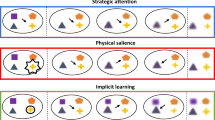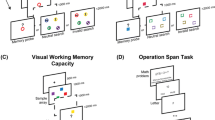Abstract
It is well known that attention is biased toward a stimulus matching working memory contents. However, it has been debated at which processing stage this memory-driven attentional bias takes place. While some studies show that memory-driven attention affects the early, perceptual stage of information processing, others argue that the finding showing such an effect is the result of working memory contents reducing uncertainty regarding the location of a target stimulus, without affecting the perception of the target. The present study tested whether a previous finding showing the perceptual effect of memory-driven attention is solely due to reduced target location uncertainty. We found that attentional bias by working memory contents affected the perception of a target stimulus, especially when multiple stimuli were present, competing against each other. This perceptual effect was not due to reduced target location uncertainty because the target location was always indicated by a response cue. Similar results were found regardless of whether working memory contents predicted the target location or not. These findings suggest that automatic, involuntary orienting of attention by working memory contents affects perception by resolving stimulus-driven competition.



Similar content being viewed by others
References
Awh, E., Sgarlata, A. M., & Kliestik, J. (2005). Resolving visual interference during covert spatial orienting: Online attentional control through static records of prior visual experience. Journal of Experimental Psychology: General, 134(2), 192–206.
Beck, D. M., & Kastner, S. (2009). Top-down and bottom-up mechanisms in biasing competition in the human brain. Vision Research, 49, 1154–1165.
Brainard, D. H. (1997). The psychophysics toolbox. Spatial Vision, 10, 433–436.
Carlisle, N. B., & Woodman, G. F. (2013). Reconciling conflicting electrophysiological findings on the guidance of attention by working memory. Attention, Perception, & Psychophysics, 75(7), 1330–1335.
Carrasco, M., Williams, P. E., & Yeshurun, Y. (2002). Covert attention increases spatial resolution with or without masks: Support for signal enhancement. Journal of Vision, 2, 467–479.
Cohen, J. (1988). Statistical power analysis for the behavioral science (2nd ed.). Hillsdale, NJ: Lawrence Earlbaum Associates.
Cosman, J. D., & Vecera, S. P. (2011). The contents of visual working memory reduce uncertainty during visual search. Attention, Perception, & Psychophysics, 73(4), 996–1002.
Desimone, R., & Duncan, J. (1995). Neural mechanisms of selective visual attention. Annual Review of Neuroscience, 18, 193–222.
Dosher, B. A., & Lu, Z. L. (2000). Mechanisms of perceptual attention in precuing of location. Vision Research, 40, 1269–1292.
Downing, P. E. (2000). Interactions between visual working memory and selective attention. Psychological Science, 11(6), 467–473.
Duncan, J. (1998). Converging levels of analysis in the cognitive neuroscience of visual attention. Philosophical Transactions of the Royal Society of London. Series B: Biological Sciences, 353(1373), 1307–1317.
Hamker, F. H. (2004). A dynamic model of how feature cues guide spatial attention. Vision Research, 44(5), 501–521.
Hamker, F. H. (2005). The reentry hypothesis: The putative interaction of the frontal eye field, ventrolateral prefrontal cortex, and areas V4, IT for attention and eye movement. Cerebral Cortex, 15(4), 431–447.
Han, S. W., & Kim, M. S. (2008). Spatial working memory load impairs signal enhancement, but not attentional orienting. Perception & Psychophysics, 70, 916–923.
Han, S. W., & Kim, M. S. (2009). Do the contents of working memory capture attention? Yes, but cognitive control matters. Journal of Experimental Psychology: Human Perception and Performance, 35(5), 1292–1302.
Han, S. W., & Marois, R. (2014). The effects of stimulus-driven competition and task set on involuntary attention. Journal of Vision, 14(4):14, 1–24.
Herrmann, K., Montaser-Kouhsari, L., Carrasco, M., & Heeger, D. J. (2010). When size matters: Attention affects performance by contrast or response gain. Nature Neuroscience, 13, 1554–1559.
Hollingworth, A., Matsukura, M., & Luck, S. J. (2013). Visual working memory modulates rapid eye movements to simple onset targets. Psychological Science, 24(5), 790–796.
Kang, M. S., Hong, S. W., Blake, R., & Woodman, G. F. (2011). Visual working memory contaminates perception. Psychonomic Bulletin and Review, 18(5), 860–869.
Ling, S., & Carrasco, M. (2006). Sustained and transient covert attention enhance the signal via different contrast response functions. Vision Research, 46, 1210–1220.
Liu, T., Stevens, S. T., & Carrasco, M. (2007). Comparing the time course and efficacy of spatial and feature-based attention. Vision Research, 47(1), 108–113.
Lu, Z.-L., & Dosher, B. (1998). External noise distinguishes attention mechanisms. Vision Research, 38, 1183–1198.
Luck, S. J., Hillyard, S. A., Mouloua, M., & Hawkins, H. L. (1996). Mechanisms of visual-spatial attention: Resource allocation or uncertainty reduction? Journal of Experimental Psychology: Human Perception and Performance, 22, 725–737.
Luck, S. J., & Thomas, S. J. (1999). What variety of attention is automatically captured by peripheral cues? Perception & Psychophysics, 61, 1424–1435.
Mendoza, D., Schneiderman, M., Kaul, C., & Martinez-Trujillo, J. (2011). Combined effects of feature-based working memory and feature-based attention on the perception of visual motion direction. Journal of Vision, 11(1), 11.
Moore, C. M., & Egeth, H. (1998). How does feature-based attention affect visual processing? Journal of Experimental Psychology: Human Perception and Performance, 24, 1296–1310.
Mordkoff, J. T., & Egeth, H. E. (1993). Response time and accuracy revisited: Converging support for the interactive race model. Journal of Experimental Psychology: Human Perception and Performance, 19, 981–991.
Olivers, C. N., Meijer, F., & Theeuwes, J. (2006). Feature-based memory-driven attentional capture: Visual working memory content affects visual attention. Journal of Experimental Psychology: Human Perception and Performance, 32(5), 1243–1265.
Pelli, D. G. (1997). The VideoToolbox software for visual psycho-physics: Transforming numbers into movies. Spatial Vision, 10, 437–442.
Peters, J. C., Roelfsema, P. R., & Goebel, R. (2012). Task-relevant and accessory items in working memory have opposite effects on activity in extrastriate cortex. Journal of Neuroscience, 32(47), 17003–17011.
Prinzmetal, W., Ha, R., & Khani, A. (2010). The mechanisms of involuntary attention. Journal of Experimental Psychology: Human Perception and Performance, 36, 255–267.
Prinzmetal, W., McCool, C., & Park, S. (2005). Attention: Reaction time and accuracy reveal different mechanisms. Journal of Experimental Psychology: General, 134, 73–92.
Santee, J. L., & Egeth, H. E. (1982). Do reaction time and accuracy measure the same aspect of letter recognition? Journal of Experimental Psychology: Human Perception and Performance, 8, 489–501.
Sawaki, R., & Luck, S. J. (2011). Active suppression of distractors that match the contents of visual working memory. Visual Cognition, 19(7), 956–972.
Sawaki, R., & Luck, S. J. (2013). Active suppression after involuntary capture of attention. Psychonomic Bulletin and Review, 20(2), 296–301.
Scocchia, L., Valsecchi, M., Gegenfurtner, K. R., & Triesch, J. (2013). Visual working memory contents bias ambiguous structure from motion perception. PLoS ONE, 8(3), e59217.
Shiu, L.-P., & Pashler, H. (1994). Negligible effect of spatial precuing in identification of single digits. Journal of Experimental Psychology: Human Perception and Performance, 20, 1037–1054.
Soto, D., Greene, C. M., Chaudhary, A., & Rotshtein, P. (2012a). Competition in working memory reduces frontal guidance of visual selection. Cerebral Cortex, 22(5), 1159–1169.
Soto, D., Greene, C. M., Kiyonaga, A., Rosenthal, C. R., & Egner, T. (2012b). A parieto-medial temporal pathway for the strategic control over working memory biases in human visual attention. Journal of Neuroscience, 32(49), 17563–17571.
Soto, D., Heinke, D., Humphreys, G. W., & Blanco, M. J. (2005). Early, involuntary top-down guidance of attention from working memory. Journal of Experimental Psychology: Human Perception and Performance, 31(2), 248–261.
Soto, D., Hodsoll, J., Rotshtein, P., & Humphreys, G. W. (2008). Automatic guidance of attention from working memory. Trends in Cognitive Science, 12(9), 342–348.
Soto, D., Wriglesworth, A., Bahrami-Balani, A., & Humphreys, G. W. (2010). Working memory enhances visual perception: Evidence from signal detection analysis. Journal of Experimental Psychology: Learning, Memory, and Cognition, 36(2), 441–456.
Woodman, G. F., & Luck, S. J. (2007). Do the contents of visual working memory automatically influence attentional selection during visual search? Journal of Experimental Psychology: Human Perception and Performance, 33(2), 363–377.
Zhang, W., & Luck, S. J. (2009). Feature-based attention modulates feedforward visual processing. Nature Neuroscience, 12, 24–25.
Acknowledgments
This work was supported by the Brain Korea 21 Plus Project in 2014.
Author information
Authors and Affiliations
Corresponding author
Rights and permissions
About this article
Cite this article
Han, S.W. Working memory contents enhance perception under stimulus-driven competition. Mem Cogn 43, 432–440 (2015). https://doi.org/10.3758/s13421-014-0460-8
Published:
Issue Date:
DOI: https://doi.org/10.3758/s13421-014-0460-8




